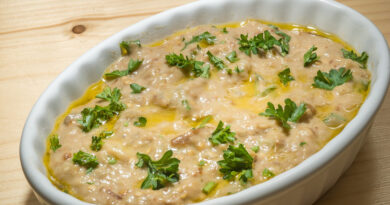Wat- An African Dish
“Wat: A Culinary Journey through Ethiopia’s Flavorful Heart”
Introduction
In the vast and diverse landscape of African cuisine, Ethiopia stands out as a treasure trove of flavors, spices, and culinary traditions. At the heart of Ethiopian gastronomy lies a dish that is as rich in history as it is in taste – “Wat.” This traditional stew, often considered the soul of Ethiopian cooking, has deep cultural roots and a complexity of flavors that make it a culinary masterpiece. In this article, we’ll embark on a delicious journey to explore the origins, ingredients, preparation, and cultural significance of Wat.
Origins and Cultural Significance
Wat holds a special place in the hearts and homes of Ethiopians, and its origins can be traced back centuries. The dish is a cornerstone of Ethiopian culture and is integral to communal gatherings, celebrations, and religious festivals. Wat is often prepared during special occasions, symbolizing hospitality, unity, and the sharing of good fortune.
The term “Wat” itself is derived from the Amharic language, which is one of Ethiopia’s many diverse languages. It refers to a variety of stews, and the dish can take on different forms based on regional variations and family recipes. Whether served in humble homes or upscale restaurants, Wat remains a beloved and iconic part of Ethiopian culinary heritage.
Key Ingredients that Define Wat
Wat is known for its robust and aromatic flavors, achieved through a careful selection of ingredients. The primary components include:
- Berbere Spice Blend: At the heart of Wat is the berbere spice blend, a fiery mixture that typically includes chili peppers, garlic, ginger, basil, and a variety of aromatic spices. This spice blend gives Wat its distinctive, complex flavor profile, ranging from spicy and smoky to slightly sweet.
- Niter Kibbeh (Spiced Clarified Butter): Another essential ingredient is niter kibbeh, a spiced clarified butter infused with spices like cardamom, cinnamon, and cloves. Niter kibbeh adds richness and depth to the stew, contributing to its signature taste.
- Meat: Wat is commonly prepared with various types of meat, such as beef, chicken, lamb, or goat. The choice of meat influences the overall character of the dish, with each variety bringing its own unique flavor.
- Vegetables: Vegetables like onions, tomatoes, and sometimes carrots are integral to Wat, providing texture, sweetness, and additional layers of flavor.
Types of Wat
Ethiopian cuisine boasts several types of Wat, each with its own distinct preparation and flavor profile. Some notable variations include:
- Doro Wat: Perhaps the most famous type of Wat, Doro Wat is a spicy chicken stew often prepared during festive occasions. The dish features chicken simmered in a rich berbere sauce and is traditionally served with injera, a sourdough flatbread.
- Key Wat: This version of Wat is centered around beef and is characterized by its bold, spicy flavors. Key Wat showcases the prowess of the berbere spice blend and is often enjoyed with injera or rice.
- Alicha Wat: Contrasting with the fiery nature of Doro and Key Wat, Alicha Wat is a milder stew that typically features a variety of vegetables, including potatoes and carrots. It offers a delightful balance of flavors and is an excellent choice for those who prefer a less spicy option.
Preparing Wat: A Labor of Love
The preparation of Wat is a meticulous and time-consuming process that involves slow cooking and layering of flavors. Here’s a simplified overview of the steps involved in making a basic Wat:
- Prepare the Berbere Spice Blend: Toast and grind a selection of spices, including chili peppers, garlic, ginger, and other aromatic ingredients, to create the Berbere spice blend.
- Prepare the Niter Kibbeh: Infuse clarified butter with a mixture of spices to create a flavorful niter kibbeh.
- Sauté Onions and Tomatoes: Begin by sautéing onions and tomatoes in the niter kibbeh until they form a fragrant base for the stew.
- Add Berbere Spice Blend: Stir in the berbere spice blend, allowing the flavors to meld and infuse the base with its characteristic heat.
- Add Meat: Introduce the chosen meat, allowing it to brown and absorb the spicy, aromatic sauce.
- Simmer to Perfection: Add water or broth and let the stew simmer slowly, allowing the meat to become tender and the flavors to develop.
- Serve with Injera: Wat is traditionally served with injera, a sourdough flatbread that complements the stew’s flavors. The injera also serves as a utensil, used to scoop up the stew and create a delightful culinary experience.
Culinary Diversity Across Regions
Ethiopia’s diverse regions contribute to the richness of its culinary landscape, and Wat is no exception. Each region may have its own variation of the dish, influenced by local ingredients, climate, and cultural nuances. For example:
- Addis Ababa: In the capital city, Addis Ababa, you might find a bustling culinary scene where Wat is served in both traditional and contemporary settings. Restaurants here may offer creative interpretations of the classic dish while maintaining its authentic essence.
- Gondar: In the historical city of Gondar, known for its ancient castles, Wat might be prepared with a regional twist, showcasing local spices and culinary techniques.
- Tigray: The Tigray region, with its distinct cultural identity, may feature Wat variations that highlight unique spices and flavors specific to the area.
The Social Aspect of Wat
In Ethiopia, sharing a meal is not just a physical act but a deeply social and communal experience. Wat embodies this spirit of sharing and togetherness, often bringing families and communities together around a common table. The act of breaking bread, or in this case, tearing off a piece of injera to scoop up the savory stew, fosters a sense of connection and unity.
Moreover, Ethiopian hospitality places great emphasis on ensuring guests are well-fed and satisfied. Wat, with its generous portions and bold flavors, exemplifies this tradition of warm hospitality. It’s not uncommon for Ethiopians to express their goodwill and friendship through the act of sharing a delicious pot of Wat.
The Global Influence of Ethiopian Cuisine
In recent years, Ethiopian cuisine, including Wat, has gained recognition and popularity on the global stage. As food enthusiasts and chefs seek new and exciting flavors, Ethiopian restaurants have emerged in various corners of the world. The communal and interactive nature of Ethiopian dining, where friends and family gather around a shared platter, has resonated with people seeking a unique and memorable culinary experience.
Ethiopian restaurants outside of Ethiopia often offer a diverse menu featuring different types of Wat, allowing diners to explore the variety and complexity of this iconic dish. The use of injera as both a serving vessel and an integral part of the meal adds an interactive and hands-on element to the dining experience.
Conclusion: Wat as a Culinary Masterpiece
In the realm of African cuisine, Wat stands as a shining example of the culinary artistry that thrives in Ethiopia. Beyond being a flavorful and aromatic stew, Wat embodies the spirit of Ethiopian culture, history, and hospitality. Its rich and diverse variations reflect the country’s geographical and cultural tapestry, making it a dish that is both deeply rooted in tradition and dynamic.



